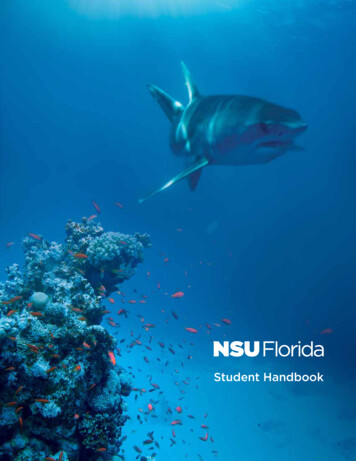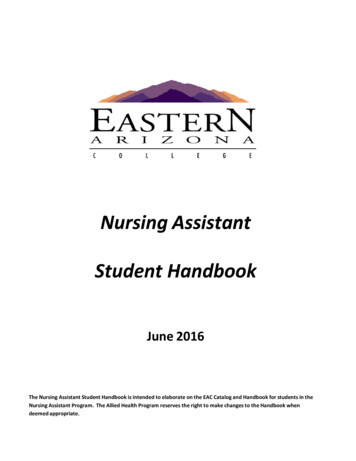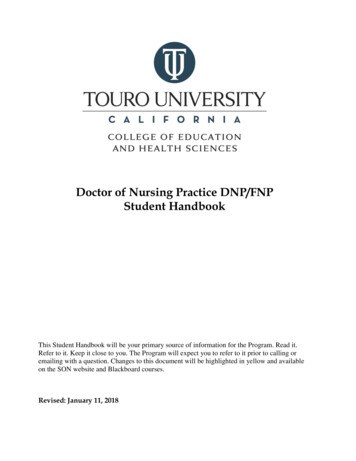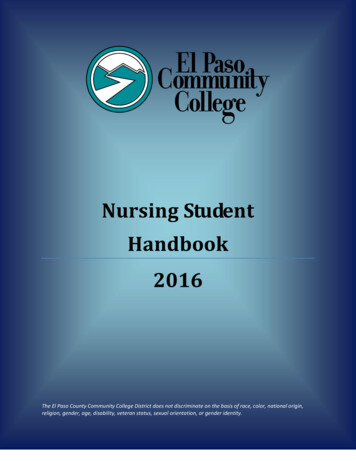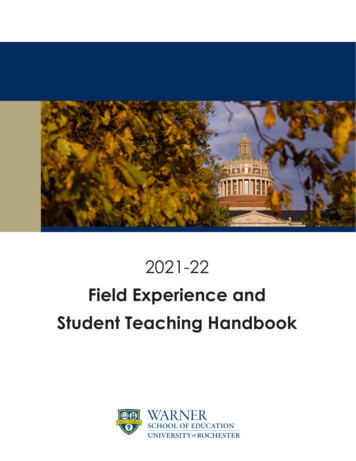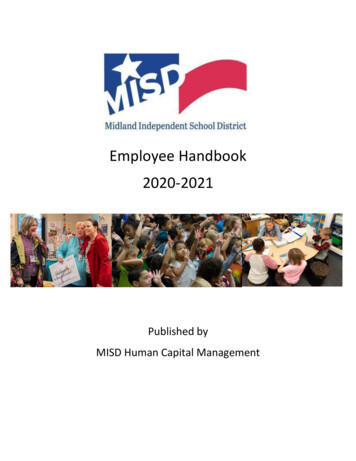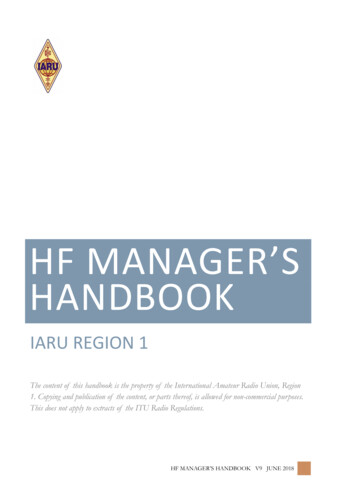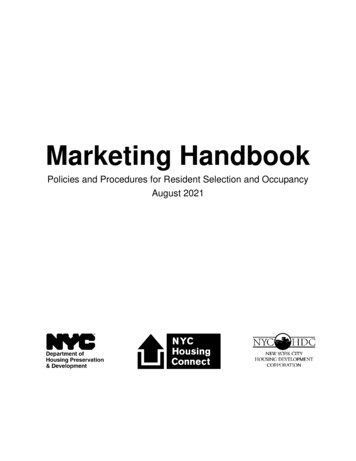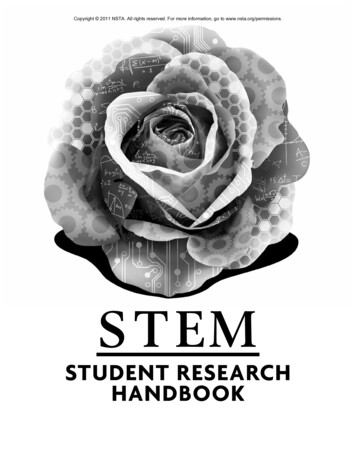
Transcription
Copyright 2011 NSTA. All rights reserved. For more information, go to www.nsta.org/permissions.STUDENT RESEARCHHANDBOOK
Copyright 2011 NSTA. All rights reserved. For more information, go to www.nsta.org/permissions.
Copyright 2011 NSTA. All rights reserved. For more information, go to www.nsta.org/permissions.STUDENT RESEARCHHANDBOOKDarci J. HarlandArlington, Virginia
Copyright 2011 NSTA. All rights reserved. For more information, go to www.nsta.org/permissions.Claire Reinburg, DirectorJennifer Horak, Managing EditorAndrew Cooke, Senior EditorJudy Cusick, Senior EditorWendy Rubin, Associate EditorAmy America, Book Acquisitions CoordinatorART AND DESIGNWill Thomas Jr., DirectorJoseph Butera, Senior Graphic Designer, Cover and Interior DesignMary McCubbins, Group Icon IllustratorPRINTING AND PRODUCTIONCatherine Lorrain, DirectorNATIONAL SCIENCE TEACHERS ASSOCIATIONFrancis Q. Eberle, PhD, Executive DirectorDavid Beacom, PublisherCopyright 2011 by the National Science Teachers Association.All rights reserved. Printed in the United States of America.14 13 12 114 3 2 1Library of Congress Cataloging-in-Publication DataHarland, Darci J., 1972STEM student research handbook / by Darci J. Harland.p. cm.Includes bibliographical references and index.ISBN 978-1-936137-24-4 (alk. paper)1. Research--Study and teaching (Secondary) I. Title.Q180.A1H37 2011507.1’2--dc232011023245eISBN 978-1-936137-41-1NSTA is committed to publishing material that promotes the best in inquiry-based science education. However,conditions of actual use may vary, and the safety procedures and practices described in this book are intended toserve only as a guide. Additional precautionary measures may be required. NSTA and the authors do not warrant orrepresent that the procedures and practices in this book meet any safety code or standard of federal, state, or localregulations. NSTA and the authors disclaim any liability for personal injury or damage to property arising out of orrelating to the use of this book, including any of the recommendations, instructions, or materials contained therein.PERMISSIONSBook purchasers may photocopy, print, or e-mail up to five copies of an NSTA book chapter for personal use only;this does not include display or promotional use. Elementary, middle, and high school teachers may reproduceforms, sample documents, and single NSTA book chapters needed for classroom or noncommercial, professionaldevelopment use only. E-book buyers may download files to multiple personal devices but are prohibited fromposting the files to third-party servers or websites, or from passing files to non-buyers. For additional permission tophotocopy or use material electronically from this NSTA Press book, please contact the Copyright Clearance Center(CCC) (www.copyright.com; 978-750-8400). Please access www.nsta.org/permissions for further information aboutNSTA’s rights and permissions policies.
Copyright 2011 NSTA. All rights reserved. For more information, go to ace.xiiiAbout the Author.xvAcknowledgments.xviIntroduction. xviiTo the Teacher. xviiTo the High School Student.xxvChapter 1Beginning a STEM Research ProjectIntroduction. 1Generating Research Ideas. 4Focusing Preliminary Research Topics. 8Safety and Ethical Issues. 9Chapter Questions. 11Chapter Applications. 12References. 13Student Handout #1: Focusing Preliminary Research Ideas. 14Chapter 2Research DesignIntroduction. 15Components of a STEM Experimental Research Design. 17Difference Between Quantitative Data and Qualitative Data. 26Chapter Questions. 31Chapter Applications. 32References. 32Student Handout #2: Research Design Table . 33v
Copyright 2011 NSTA. All rights reserved. For more information, go to www.nsta.org/permissions.CONTENTSChapter 3Background Research and Note TakingIntroduction. 35Writing Background Research Questions. 36Starting Background Research Early. 38Identifying Reliable Scientific Resources. 38Methods of Note Taking. 40Avoiding Plagiarism. 47Using Quotations Within the Paper. 48Technology Research Tools. 49Chapter Questions. 52Chapter Applications. 52References. 53Student Handout #3: Background Research Questions. 54Notebook Organizer . 55Chapter 4Writing HypothesesIntroduction. 57Writing Drafts of the Hypothesis. 58Chapter Questions. 61Chapter Applications. 62References. 62Student Handout #4: Practicing Writing Hypotheses. 63vi
Copyright 2011 NSTA. All rights reserved. For more information, go to www.nsta.org/permissions.CONTENTSChapter 5Proposal WritingIntroduction. 67The Proposal Components. 68Scientific Writing. 73Chapter Questions. 75Chapter Applications. 75References. 76Chapter 6Organizing a Laboratory NotebookIntroduction. 77Data Collection Issues for Groups. 80Components of a Laboratory Notebook. 82Conclusions. 91Chapter Questions. 92Chapter Applications. 92References. 92Chapter 7Descriptive StatisticsIntroduction. 93Recording Calculations in Your Laboratory Notebook. 93Introduction to Descriptive Statistics. 95Using Descriptive Statistics to Explain Experimental Results. 108Chapter Applications. 108References. 108vii
Copyright 2011 NSTA. All rights reserved. For more information, go to www.nsta.org/permissions.CONTENTSChapter 8Graphical RepresentationsIntroduction.111Graphical Representation for Quantitative Data. 113Graphical Representations for Qualitative Data. 124Making Final Graphical Representations. 127Chapter Applications. 128References. 129Chapter 9Inferential Statistics and DataInterpretationIntroduction. 131Introduction to Inferential Statistical Tests. 132Data Interpretation. 138Chapter Applications. 141References. 141Student Handout #5: Interpreting Graphical and Statistical Data:A Peer Editing Exercise.142Chapter 10Documentation and Research Paper SetupIntroduction. 145Three Aspects of MLA Documentation. 147Amount of Documentation and Use of Quotations. 151Research Paper Setup. 151Chapter Questions. 153Chapter Applications. 153viii
Copyright 2011 NSTA. All rights reserved. For more information, go to www.nsta.org/permissions.CONTENTSChapter 11Writing the STEM Research PaperIntroduction. 155Parts of the STEM Research Paper. 157Personal Reflections. 165Abstract (for Oral and Poster Presentations). 166Preparing the Paper for Submission. 167Materials to Accompany the Paper. 167Chapter Question. 167Chapter Applications. 168Reference. 168Recommended Resources. 168Student Handout #6: Form for Peer Editor of STEM Research Paper .169Chapter 12Presenting the STEM Research ProjectIntroduction. 177Oral Presentations. 177Oral Poster Presentations. 183Chapter Questions. 186Chapter Applications. 186Appendix A: Research Project Due Dates Checklist. 191Appendix B: Research Presentations Observation Sheet. 193Appendix C: Research Paper Grade Sheet. 195Appendix D: Research Paper Grading Rubric. 199Appendix E: Oral Presentation Rubric. 209Appendix F: Judge’s Score Sheet for STEM Research Projects. 213Index. 215ix
Copyright 2011 NSTA. All rights reserved. For more information, go to www.nsta.org/permissions.
Copyright 2011 NSTA. All rights reserved. For more information, go to www.nsta.org/permissions.DEDICATIONThis book is dedicated to all my former students. I am indebted toeach of you. Your willingness to work hard, with minimal grumbling, has been an inspiration. My goal was never to turn each ofyou into STEM researchers but rather to help you gain a clear understanding of how scientific knowledge is acquired. I thank you for puttingup with my inadequacies and my pat sayings and for trusting me when I toldyou the hard work would pay off.STEM Student research handbookxi
Copyright 2011 NSTA. All rights reserved. For more information, go to www.nsta.org/permissions.
Copyright 2011 NSTA. All rights reserved. For more information, go to www.nsta.org/permissions.PREFACEOur nation’s success depends on strengthening America’s role as theworld’s engine of discovery and innovation. CEOs understand thattheir company’s future depends on their ability to harness the creativityand dynamism and insight of a new generation. And that leadershiptomorrow depends on how we educate our students today—especiallyin science, technology, engineering and math.—President Barack Obama, September 16, 2010 (Sabochik 2010)The importance of improving science, technology, engineering, andmathematics (STEM) education has become a popular topic in recent years. It is clear, however, that the STEM education that today’shigh school students receive rarely mirrors what individuals inSTEM careers actually do. Students are focused more on memorization thanon identifying problems and finding ways to solve those problems. STEMStudent Research Handbook engages students with the same inquiry skills usedby STEM professionals. The handbook supports students as they practiceskills of designing and conducting experiments and analyzing and presenting their findings.I believe that the primary reason STEM educators do not include studentdirected research as part of their curriculum is that they themselves havelimited experience in this area. My goal in writing this book was to providea practical resource that teachers and students can use to become activelyengaged with topics that interest them as they are guided through the stages ofa long-term research project. I hope that this handbook bridges a gap betweenSTEM professionals and classroom teachers by providing a resource that willhelp students experience learning in the way scientists do, by doing research.My experience is similar to that of many other teachers who at one pointdecide to implement a research component in their classrooms. Havingdesigned and completed only one science experiment on my own as an undergraduate and only educational research as a graduate student, I was uncertainabout my ability to lead high school students in performing research. WhenI received the first set of student research papers, it was obvious that I hadto make changes in how I supported students through the research process.Over the years, as I identified resources, modified deadlines, and developedSTEM Student research handbookxiii
Copyright 2011 NSTA. All rights reserved. For more information, go to www.nsta.org/permissions.PREFACEactivities that helped students to implement the scientific process for themselves, I saw student research papers improve greatly. This handbook is acompilation of years of work, lessons learned from mistakes, and the goodadvice of other teachers and STEM professionals.The handbook addresses the two major aspects of conducting research:planning and conducting experiments and then analyzing and communicating results through writing. First, the handbook provides a structure for STEMteachers to use as they work through the stages of the research process withtheir students. There is enough detail here so that even teachers who havenever designed an experiment on their own can feel comfortable guidingstudents through theirs. Second, large segments of the handbook address thewriting (aka language arts) issues involved with research. I believe that STEMteachers who are not specially trained in writing will find the writing instructions here to be invaluable. As a science teacher who has also studied andtaught English, I have been able to help STEM students see the importance ofcommunicating their results through effective writing. Whole chapters in thisbook cover note-taking techniques, proper documentation of research papers,and presentation preparation. Sadly, in-depth writing advice is commonlymissing from other books teaching students how to conduct research.The opportunity to design and conduct an experiment and then presentthe findings at local symposia has changed the lives of many of my high schoolstudents. They learned to take the initiative for their own learning, and manychose to enter STEM-related fields when they went to college. As I got betterat leading my students through STEM research projects that they were reallyinterested in, they started winning awards at the competitions, bringing hometop prizes. In 2004, I was awarded the Sigma Xi (Illinois State University/Illinois Wesleyan University chapter) Outstanding Science Teacher Award formy students’ contributions to these competitions and for encouraging otherlocal teachers to implement long-term research projects. Most rewardingto me, however, has been that my students actually performed the excitingresearch process from beginning to end and acquired better understandingsof how STEM knowledge is advanced. That experience is completely differentfrom listening to a lecture, observing a STEM professional on the job, or evenperforming hands-on labs that someone else designed.ReferenceSabochik, K. 2010. Changing the equation in STEM education. The Whitehouse Blog: on-stem-education.xivNational Science Teachers Association
Copyright 2011 NSTA. All rights reserved. For more information, go to www.nsta.org/permissions.ABOUT THE AUTHORDarci J. Harland, PhD, a former biology and English teacher, is the assistantdirector of research at the Center for Mathematics, Science, and Technology(CeMaST) at Illinois State University. Her educational experiences range fromundergraduate and graduate education and biology courses, to high schooland middle school science and English courses. Her research interests includethe long-term impact of scientific research performed by high school andundergraduate students, the influence of personality on online and face-toface classroom participation, the use of digital media as a tool for reflection,and the level of inquiry in one-to-one laptop classrooms.STEM Student research handbookxv
Copyright 2011 NSTA. All rights reserved. For more information, go to www.nsta.org/permissions.acknowledgmentsI would like to thank a number of individuals for the support and assistancethey provided through the evolution of my life as well as the evolution of theSTEM Student Research Handbook.First of all, I am grateful to my parents, Craighton and LindaHippenhammer. I am extremely appreciative for having been raised in ahome that cultivated a wonder for the amazing world we live in and encouraged me to learn as much about it as possible. I am thankful for my husband,Craig, and my two boys who supported me during the long hours of writing.A special thanks to the staff at the Center for Mathematics, Science, andTechnology (CeMaST) at Illinois State University: Dr. William Hunter, whoseencouraging words kept me writing when I wanted to quit; Ydalisse Pérez,Nicole Enzinger, and Dr. Jeff Helms, who contributed writing and conceptual support in areas where I am weak; Mary McCubbins for her expertise ingraphic design; and Sara McCubbins and Amanda Fain for their editing.Thanks also to Dr. Randall Johnson at Olivet Nazarene University, whomodeled natural inquisitiveness whenever he asked, “How does it know?” Ithank him for providing my first opportunity to conduct STEM research asan undergraduate in his ecology course. I now have an appreciation for therestraint he displayed when he answered my questions with more questions.He is an exemplary teacher.Last, but not least, I am grateful to Suzanne McGroarty, the veteranteacher whose shoes I attempted to fill after her retirement. She inspired thisbook! I so appreciate “the McGroarty legacy” and the opportunities I hadto improve myself as a teacher because of it. Sue’s love of science, genuineconcern for her students, and positive attitude as a career-long teacher trulyhave made her an inspiration and model to STEM teachers everywhere.xviNational Science Teachers Association
Copyright 2011 NSTA. All rights reserved. For more information, go to www.nsta.org/permissions.INTRODUCTIONTo the TeacherIf you are a high school STEM or other kind of science teacher, you mostlikely already understand the value of having students do science. However,even with our best efforts to include inquiry in our teaching, the logisticsof organizing learning experiences that encourage students to ask questionsthat they themselves answer is overwhelming. If you have considered, or areconsidering, implementing student-centered, long-term research projects, myguess is you have a few questions, such as, How do I monitor students doingvarious projects, at various stages? What if students want to design an experiment on a topic I know nothing about? What if the students get in over theirheads? Can I include long-term research projects as part of my curriculumand still cover the required content? How can I ask my students to design anexperiment if I have never done one? Questions like these are enough to sendany teacher into a tailspin and to drop the idea forever. However, I am here totell you, it can be done, and this handbook will show you how.Incorporating Research Into the High School ScienceCurriculumThere are several ways that teachers, departments, and schools incorporatelong-term research projects into the science curriculum. Sometimes it startswith a single teacher helping a few ambitious students who perform theirown research before and after school. Other teachers add a long-term researchproject to an existing course and then work diligently to balance the contentthey need to address with the support students need to complete their projects. Some science departments systematically include research componentsthroughout the curriculum, so that upon graduating, students have conductedmultiple research projects at varying levels of difficulty. Sometimes a schoolis able to dedicate an entire course to student-centered research or provide asimilar experience in summer enrichment opportunities. This handbook waswritten for any of the above scenarios.Whatever your situation, I advise you to first decide how much timeyou want to dedicate to a research project and then decide on deadlines.As with any other unit plan, start with the end in mind. When do you wantto have the research project (either a paper or poster presentation) in yourSTEM Student research handbookxvii
Copyright 2011 NSTA. All rights reserved. For more information, go to LOGYENGINEERINGMATHEMATICShands to grade? Once you have determined the final deadline, set deadlinesto assess your students along the way. This handbook provides supportin the construction of deadlines on several fronts. Appendix A is a samplechecklist for developing deadlines. More indirectly, there are cues for youthroughout the handbook. Although I wrote the book in language directedto your high school students, you will find references to “your teacher”throughout. I intended these as cues for you. I use phrases such as, “Yourteacher may ask to see ” or “Your teacher will prefer either or ” asa prompt for you to discuss your requirements with your students. Thesecues suggest options of what sort of assessments to make along the way. Isuggest you give grades throughout the length of the project, both formallyand informally, to foster the concept of a journey of research, rather thangiving a single grade to a final product.Next you will need to decide how you want students to work—individually, in pairs, or in groups. On one hand, having students work individuallysimplifies the research process because each student performs each stage ofthe process individually and can choose a topic that is personally meaningful. For you, of course, individual projects will increase the total number ofprojects you must monitor and assess. On the other hand, allowing studentsto work in groups reduces your grading, but it does introduce other challenges—for example, students will often need guidance from you on howto divide the workload. (Throughout the handbook, a group icon—seep. xxvi—will signal tips for how groups might work together to accomplishthe task at hand.) If you do choose the group route, I suggest that throughout the process you provide time for group members to frankly discuss theirstrengths and weaknesses, evaluate themselves and each other, and assignspecific tasks to each individual in a signed contract that you also sign. EachxviiiNational Science Teachers Association
Copyright 2011 NSTA. All rights reserved. For more information, go to www.nsta.org/permissions.INTRODUCTIONABOUT THE AUTHORgroup contract should cover the background research (Chapter 3), proposal(Chapter 5), data collection (Chapter 6), paper writing (Chapter 11), and presentation (Chapter 12) stages of the research project.Using Outside MentorsYou may want to consider encouraging or even requiring your students tofind a STEM mentor within the research field that interests them. Even if youhave no local university or STEM industry companies in the vicinity, studentscan search online for possible mentors and be mentored at a distance. Yourrole when students work with a mentor is that of coach: You ensure that students meet deadlines, conduct the scientific process themselves (as much aspossible), and communicate with their mentors. Support from mentors in thefield frees you from having to be a content expert on each of the student projects. However, you are also releasing control of the level at which studentsexperience the scientific process, particularly if a student is physically working in their mentor’s lab. It is possible that the mentor’s research interests willtruncate your student’s interest in the topic or field of study.
The handbook addresses the two major aspects of conducting research: planning and conducting experiments and then analyzing and communicat-ing results through writing. First, the handbook provides a structure for STEM teachers to use as they work through the stages of t
